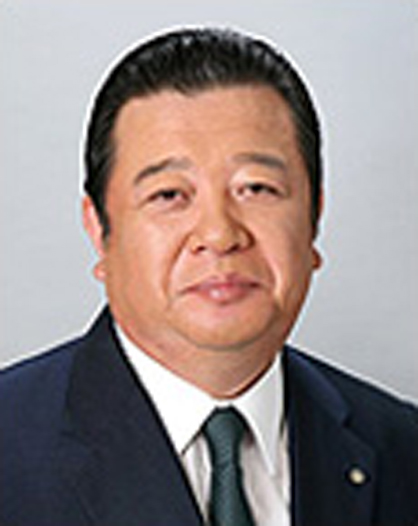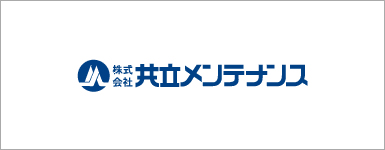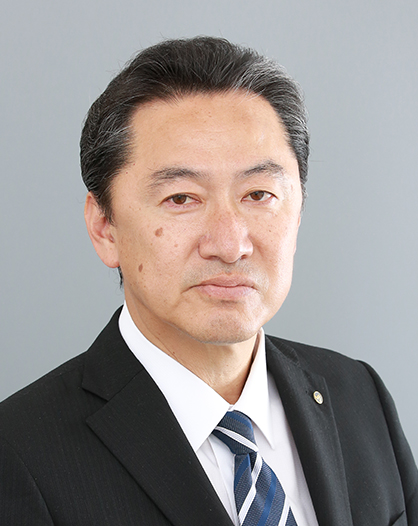| Kyoritsu Maintenance Co., Ltd. (9616) |
|
||||||||||||||
Company |
Kyoritsu Maintenance Co., Ltd. |
||
Code No. |
9616 |
||
Exchange |
TSE 1st Section |
||
Chairman |
Haruhisa Ishizuka |
||
President |
Takumi Ueda |
||
HQ Address |
2-18-8 Soto Kanda, Chiyoda-ku, Tokyo |
||
Year-end |
March |
||
URL |
|||
*Share price as of closing on December 19, 2017. Number of shares outstanding as of most recent quarter end excluding treasury shares. ROE and BPS are the values as of the end of the previous term.
|
||||||||||||||||||||||||
|
|
* Estimates are those of the Company. A 1.2 for 1 stock split was conducted on April 1, 2015. A2 for 1 stock split was conducted on April 1, 2017.
This Bridge Report provides information about Kyoritsu Maintenance Co., Ltd. including a review of its first half of the fiscal year March 2018 earnings.
|
| Key Points |
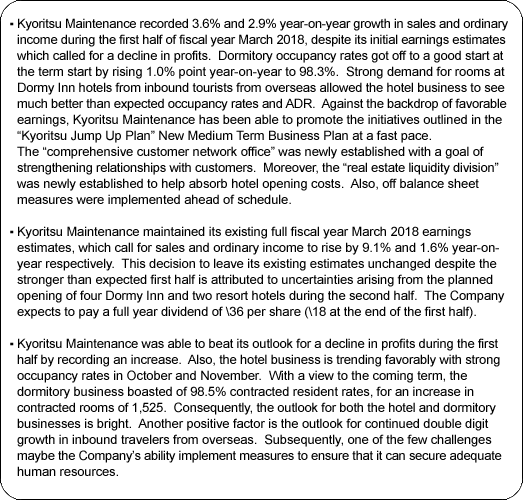 |
| Company Overview |
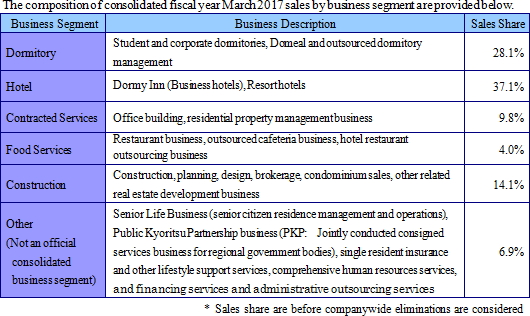 <Corporate History>
Kyoritsu Maintenance was established in September 1979. The founder, Haruhisa Ishizuka, has long been associated with the food service industry and started the Company by taking on the operations of corporate cafeteria facilities on a consigned basis. In the following year of 1980, the Company established a two story wooden structure with 28 small four Japanese straw mat rooms as its first dormitory facility in Sakura City, Chiba Prefecture. Based on the principle of providing "food" that "fosters the health and well-being of students to put their parents' minds at ease," Kyoritsu was able to steadily expand its student dormitory business through partnerships with various schools. The Company steadily expanded its operating territory to cover the Tokyo, Kanagawa, Nagoya and Osaka regions. In April 1985, Kyoritsu began offering corporate dormitories to employees that offered highly unique features of "individual rooms with commissary functions providing breakfast and dinner," and "large bathing facilities" as comforting amenities for residents. In June 1993, the Company moved its headquarters to its current location and in July of the same year it entered the resort hotel business with the opening of a facility in Nagano Prefecture, followed by their entry to the business hotel realm in August with the opening of a facility in Saitama Prefecture. In September 1994, Kyoritsu listed its shares on the JASDAQ Market (At the time called the OTC Market), in March 1999 it moved its listing to the Second Section of the Tokyo Stock Exchange, and then to the First Section in September 2001.
|
| New Medium Term Business Plan "Kyoritsu Jump Up Plan": 5 Years from Fiscal Year March 2018 to 2022 |
|
(1) "Kyoritsu Jump Up Plan" Overview
Kyoritsu seeks to increase its credibility amongst clients by creating products and services that lead to improvements in customer satisfaction.
Name: "Kyoritsu Jump Up Plan" Fundamental Strategy I. Improving Customer Satisfaction II. Anticipatory Investments in Development
Kyoritsu endeavors to create a solid business foundation by expanding its business.
Period: April 2017 to March 2022
FY3/22 Quantitative Targets: Sales and Operating Income of ¥220.0 and ¥19.0 Billion (Average annual growth of 10%) (2) Important Measures to Raise Customer Satisfaction
Kyoritsu Maintenance will implement measures to secure human resources needed to ensure that the speed of its business expansion can be maintained. Along with aggressive hiring of new graduates, efforts will be made to secure a stable supply of highly skilled human resources that can respond accurately to the needs of our customers.
1. Strengthening Human Resources Training  ↓
Fortify Training Programs: Maintain, Improve Service Levels, Fortify Training by Occupational Category
↓
Leverage Diverse Range of Human Resources: Secure and Leverage Diverse Range of Human Resources that Respond to the Trend for Globalization
↓
Improve Customer Satisfaction
2. Dormitory Business
Fortify Product Lineup, Strengthen Value Addition
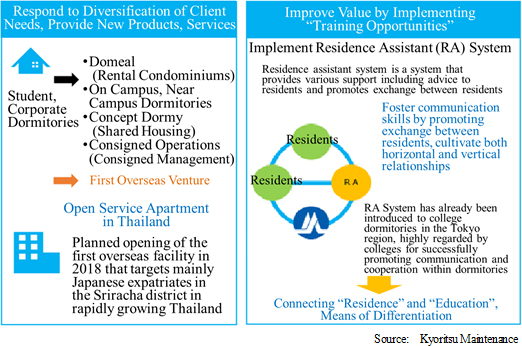 3. Hotel Business
Improve the Company's website to strengthen its influence as a sales channel.
Introduce Special Brand Memberships on Website
↓
Reduce sales channel costs including agent fees
↓
Acquire repeat customers by raising brand loyalty
↓
Expand fan, repeat customer base
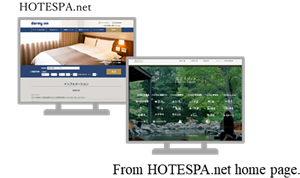 Improve usability and member privileges of corporate website. Strengthen customer base by accumulating customer information to create a benevolent cycle that yields high repeat customer usage. (3) Development Plan
Development Plan to Achieve Sustained Growth
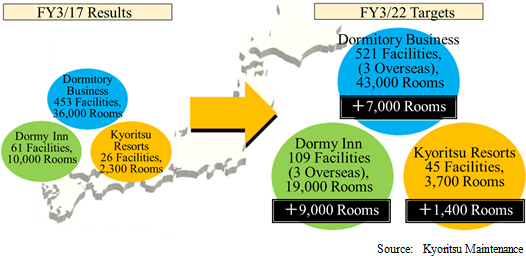 (4) Quantitative Targets
"Anticipatory Development Type" Plan to Achieve Large Leaps and Bounds"Anticipatory Development Period" from FY3/18 to FY3/19 to Achieve Accelerated Growth in FY3/20 to FY3/22 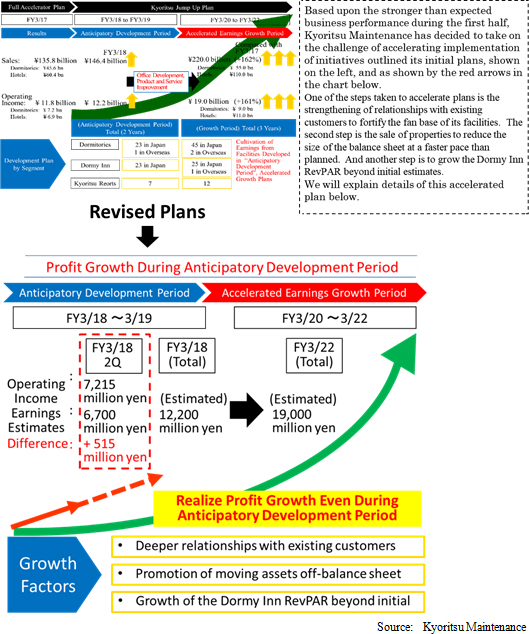 (5) Financial Strategy
A total of ¥140.0 billion is expected to be spent on developmental investments over five years. Of this total investment, ¥70.0 billion is expected to be derived from cash flow, ¥30.0 billion from off balance sheet items (Sale and leaseback), and ¥40.0 billion from external funding. Kyoritsu Maintenance expects to maintain its financial health by maintaining a debt to equity ratio of less than 1.0
(6) Dividend Payout Ratio Target
Kyoritsu Maintenance has continuously raised dividends from fiscal year March 2013 onwards, but its dividend payout ratio has remained in the 10% range. However, it maintains a target dividend payout ratio over 20% to be achieved by fiscal year March 2022.
(7) Additional Measures
New Measures Relating to Medium Term Business Plan in the First Half
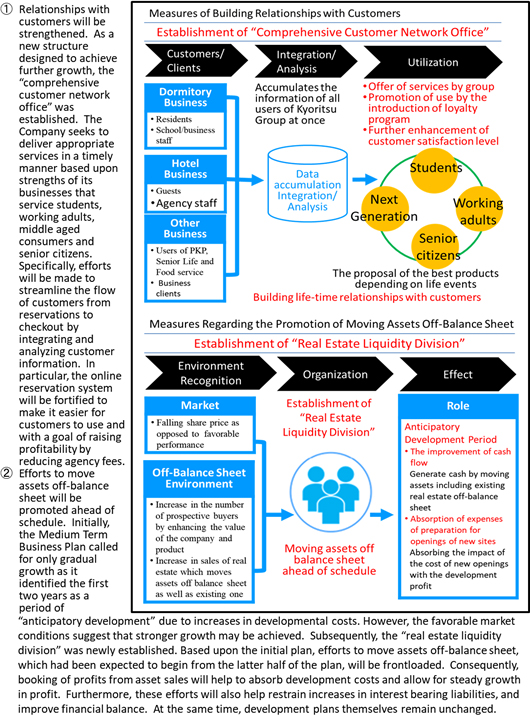 |
| First Half of Fiscal Year March 2018 Earnings Results |
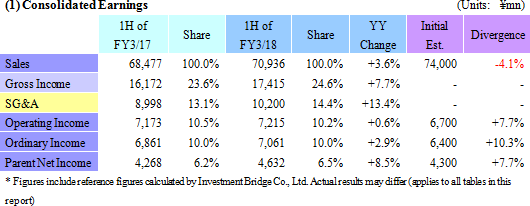 Sales, Ordinary Income Rise 3.6%, 2.9% Year-On-Year
Sales rose by 3.6% year-on-year to ¥70.936 billion on the back of favorable occupancy rates at the start of the term in the dormitory business and growth in demand from inbound travelers from overseas for the hotel business. Despite estimates for a decline in profits, operating income rose by 0.6% year-on-year to ¥7.215 billion due to the ability to absorb opening expenses arising from anticipatory development.The five year Medium Term Business Plan "Kyoritsu Jump Up Plan", which started from the current term and calls for efforts to "increase customer satisfaction" and "implement anticipatory development", got off to a strong start. 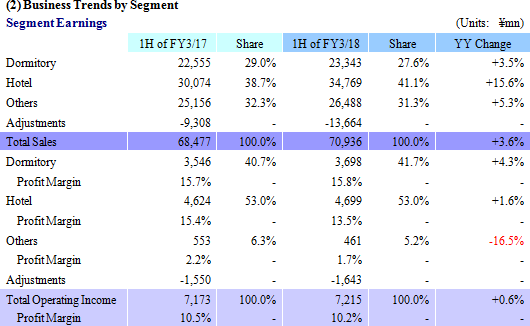 Dormitory Business
Sales and operating income rose by 3.5% and 4.3% year-on-year to ¥23.343 and ¥3.698 billion respectively.Within the dormitory business, room occupancy rates, which are a key performance indicator (KPI), got off to a good start by recording a similar level as the previous year of 98.3%. Also, the number of resident contracts rose by 597 year-on-year to 34,305 at the end of .September. Corporate dormitories also benefitted from "aggressive hiring of new graduates" and the introduction of dormitory functions as part of the corporate benefit and training programs" by corporations. Combined with an increase in consigned dormitory orders, dormitory business sales overall rose. Favorable occupancy rates throughout the first half allowed the number of corporate employee contracts to increase. Combined with growth in consigned dormitory and Domeal contracts, operating income rose to ¥152 million. Moreover, increases in student and corporate dormitory contracts amounted to ¥109 million, and growth in consigned and Dormeal contracts totaled ¥43 million. 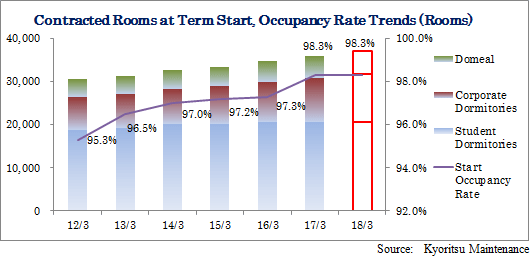 Hotel Business
Sales and operating income rose by 15.6% and 1.6% year-on-year to ¥34.769 and ¥4.699 billion respectively. Five new Dormy Inn and two new resort hotels were opened. Despite the negative influence of typhoons, existing facility occupancy rates and ADR rose compared with the previous first half. In addition, flexible allocation of human resources responding to occupancy conditions at each facility and other strict cost control measures helped to absorb development expenses and allowed operating income to rise. We provide details of the various factors influencing profits of the hotel business below.
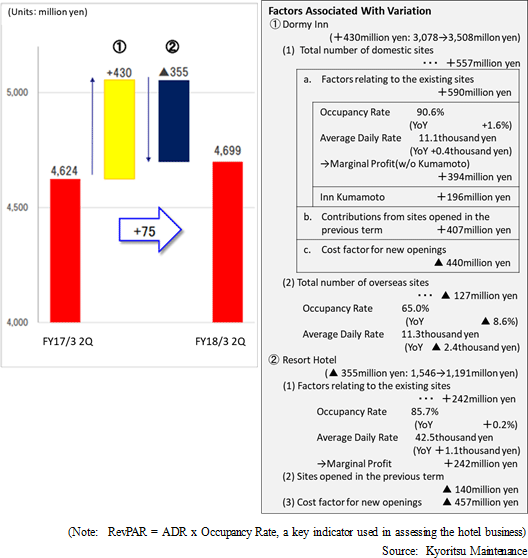 Dormy Inn (Business Hotel) Business
During the first half, five new facilities including "Myojin no Yu Dormy Inn Premium Kanda", "Natural Hot Spring Hyuga no Yu Dormy Inn Miyazaki", "Natural Hot Spring Kaijin no Yu Dormy Inn Express Sendai Seaside", "Natural Hot Spring Yakumo no Yu Dormy Inn Izumo", and "Natural Hot Spring Syoun no Yu Dormy Inn Kofu Marunouchi" were opened.Occupancy rates at existing facilities rose by 1.6% points from 89.0% to 90.6% on the back of contributions from strong occupancy rates at facilities in the Tokyo metropolitan region of 100% at Shibuya Jingumae and 96% at both the Asakusa and Ueno facilities, and facilities in the Osaka and surrounding Kansai region of 99% at Kyoto Station, 96% at both East Umeda and Shinsaibashi and 98% at two facilities in Namba. Occpuancy rates at facilities in other major cities including Nagoya and Sapporo stood at 96%, two in Hakata at 97%, and three in Sendai at 94%. At the same time, regional facilities in Takamatsu, Kurashiki, and Himeji also saw strong occupancy rates of 96%, 95% and 96% respectively. Room pricing rose by 3.7% year-on-year or ¥400 to ¥11,100, and RevPAR rose by 6.3% year-on-year for a 2.3% point rise over the initial target of a 4.0%. Amongst the 66 facilities operated by Kyoritsu Maintenance, high occupancy rates of over 95% at 16 facilities and favorable earnings appear to dispel fears that the supply and demand balance of hotels is deteriorating due to an increase in hotel supplies. Furthermore, Dormy Inn business hotels are also seeing growing use by tourist customers in addition to the traditional business related usage. High occupancy rates are also being complemented by increases in the multiple guest usage per room from 1.34 to 1.36 and in ADR. 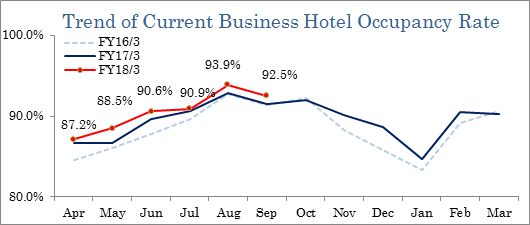  Inbound Traveler Conditions
The share of inbound travelers from overseas of total sales rose by 7.3% points year-on-year to 25.2%, and the total number of individuals staying at Kyoritsu facilities rose by 72% year-on-year to 633,000. Room pricing of inbound travelers also rose by 3.0% year-on-year to ¥13,900, and is contributing to a larger amount of profits because pricing is 25% higher than the price for Japanese guests of ¥11,000. This higher pricing is attributed to the larger amount of double occupancy or more usage by inbound travelers at an average of 1.77 guests per room, which compares with 1.27 Japanese guests per room.For example, facilities in Osaka including Nono Namba, Premium Namba, and Shinsaibashi saw occupancy rates of 95%, 76% and 80% respectively in September, while facilities in Tokyo including Asakusa, Shibuya, and Ueno Okachimachi saw rates of 55%, 52% and 43% respectively. At the same time, occupancy rates expanded at facilities nationwide including Nagoya Sakae, Nara, and two facilities in Hakata to 54%, 51%, and 43% respectively. Moreover, changes in share by nationality of overseas visitors is shown below. Country
Korea:Hong Kong: Taiwan: China: United States: Share
28.6%, up 2.3% points25.5%, up 7.1% points 12.6%, down 8.0% points 6.2%, down 3.6% points 5.6%, up 3.6% points Total Number Growth
Up 87%Up 138% Up 5% Up 9% Up 370% 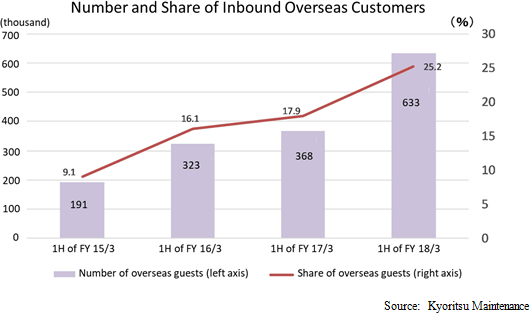 Resort Hotel Business
During the first half, Kyoritsu Maintenance opened two new facilities in the vicinity of the renowned Izumo Taisha shrine called "Inishie No Yado Keiun" and "Oyado Tsukiyo No Usagi". Existing facilities saw a rise in occupancy rates in the first quarter but saw a decline in the second quarter due to typhoons and inclement weather (1.0% point), but room pricing rose year-on-year in both quarters. The aggregated occupancy rates rose by 0.2% points from 85.5% to 85.7%, room pricing grew by 2.6% year-on-year to ¥42,500, and RevPAR rose by 3.1% year-on-year. By various regions, flagship facilities including Hakodate, Kusatsu, Hakone Gora, Kyoto Shuhokaku, and Okinawa saw occupancy rates of 95%, 93%, 91%, 97% and 94% respectively. Also new facilities including Ikyu close to Ise Shrine and Hakone Yumoto which opened in the previous term also saw high occupancy rates of 93% and 91% respectively. Facilities in other regions also remained strong.
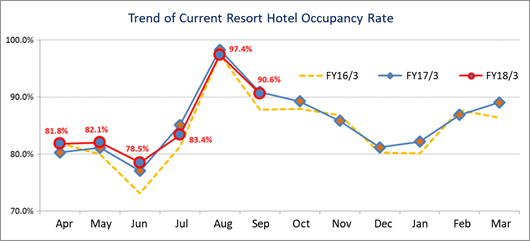  Other Business
Sales rose by 5.3% year-on-year to ¥26.488 billion, and operating income fell by 16.5% year-on-year to ¥461 million.Contracted services division sales rose by 0.2% year-on-year to ¥6.478 billion, but operating income fell by 8.5% year-on-year to ¥138 million. While sales rose, the disappearance of large construction projects in the previous term contributed to the lower profits. Sales of the food service division rose by 6.9% year-on-year to ¥3.380 billion, and operating income turned from a loss of ¥26 million from the previous term to a profit of ¥59 million in the current term. An increase in the number of consigned hotel restaurants allowed sales to grow, and unprofitable stores closures allowed operating income to improve from a loss to a profit. Sales and operating income of the construction division rose by 8.2% and 26.4% year-on-year to ¥10.676 billion and ¥395 million respectively. An increase in the number of hotel development projects allowed sales to grow while a decline in construction of condominiums for sale caused profits to decline. Other services (Not included as a reported segment) sales rose by 5.2% year-on-year to ¥5.952 billion, and an operating loss of ¥131 million was recorded (Loss of ¥108 million in the previous term). 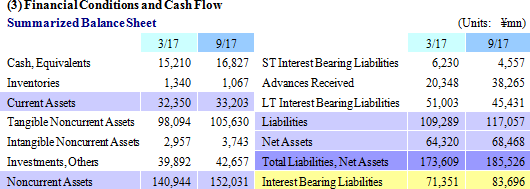 Total liabilities rose by ¥7.767 to ¥117.057 billion on the back of increases in short term loans. Net assets rose by ¥4.148 to ¥68.468 billion due to an increase in retained earnings. Capital adequacy ratio is 36.9%, declining 0.1% points from the end of the previous term. Moreover, interest bearing liabilities rose and the debt to equity ratio, which is a key management indicator, rose from 0.9 times in the previous term to 1.0, reflecting the target outlined in the Medium Term Business Plan and the financial health of the Company.  The influence of changes in accounts receivables and inventories caused the net inflow of operating cash to decline by ¥298 million from the previous term to ¥3.070 billion in the current term. Income from sales of tangible assets offset payment for deposits and security deposits to an extent and allowed the net outflow of investing cash to decline by ¥795 million to ¥13.229 billion. A net increase in short term debt offset repayments of long term debt and allowed financing cash flow to increase by ¥12.584 billion from the net outflow in the previous term to a net inflow of ¥11.803 billion. |
| Fiscal Year March 2018 Earnings Estimates |
 Earnings Estimates Call for Sales, Ordinary Income to Rise 9.1%, 1.6% Year-On-Year Respectively
Kyoritsu Maintenance has decided to maintain its full year earnings estimates unchanged and call for sales and ordinary income to rise by 9.1% and 1.6% year-on-year to ¥148.2 and ¥11.7 billion respectively. While there is a possibility for positive earnings surprises given the stronger than expected first half and strong near term operating trends, Kyoritsu has decided to maintain its estimates due in part to the opening of four new Dormy Inn and two new resort hotel facilities in the second half. The Company is expected to pay a full year dividend of ¥36 per shares (Including an ¥18 dividend paid at the end of the first half).
|
| Conclusions |
|
The Company is already beginning to review its Medium Term Business Plan "Kyoritsu Jump Up Plan", which just started in the current term, due to the strong demand for its facilities and services on the back of strong inbound travelers trends and other positive factors. Targets of the previous Medium Term Business Plan "Kyoritsu Full Accelerator Plan" were achieved one year ahead of schedule, and the Company seeks to also achieve the targets of its new Plan earlier than expected. In addition, Kyoritsu has newly established the "comprehensive customer network office" to fortify its customer relationships over the medium term. With a view to the coming term, Kyoritsu Maintenance is taking on challenges of cultivating new markets including the construction of a shared house type dormitory with 500 rooms for Waseda University students, a student dormitory for vocational schools in Naha City, Okinawa, and its first overseas facility of a serviced apartment in Thailand, which is expected to boost the total number of rooms operated by 1,700. Excluding dormitories closed, contracted resident occupancy rates stood at 98.5%, with an increase of 1,525 rooms contracted expected. High occupancy rates are expected to continue in both the hotel and dormitory business. The operating environment remains favorable, supported by strong demand from continued double digit growth in inbound travelers. Kyoritsu Maintenance is steadily implementing development of new facilities, and one of the few concerns confronting the Company is its ability to secure an adequate supply of human resources. Consequently, Kyoritsu Maintenance has identified "stably securing human resources" as a critical topic in its Medium Term Business Plan, and will promote various hiring and training measures. Shortages of human resources have become a chronic problem, and the ability to secure an adequate supply of staff in line with its business growth is a key point to keep close watch over. |
| <Reference: Regarding Corporate Governance> |
 ◎Corporate Governance Report
The company submitted the latest corporate governance report on July 26, 2017 after applying the Corporate Governance Code.<Basic Policy> Our company has, since inauguration, been following our management philosophy of "customers first" and striving for attaining our management policy of great contribution to society through provision of services for diverse life stages of people. In addition, we consider that it is essential to enrich our corporate governance system in order to achieve sustainable company development and long-term maximization of shareholder's interest and therefore take multitudinous measures, including acceleration of management decision-making, strengthening of the function of management supervision, enhanced and thorough accountability, expeditious and appropriate information disclosure, and the like. Our company has recognized that one of the most important business challenges is to secure transparency, soundness, etc. Furthermore, our company as an organization in compliance with the Companies Act has set up general meetings of shareholders, directors, the board of directors, the audit and supervisory board, and accounting auditors. We have also established management information meetings, the compliance committee, and meetings to exchange management information on our corporate group. <Implementation of each principle of the Corporate Governance Code> The company implements every principle. 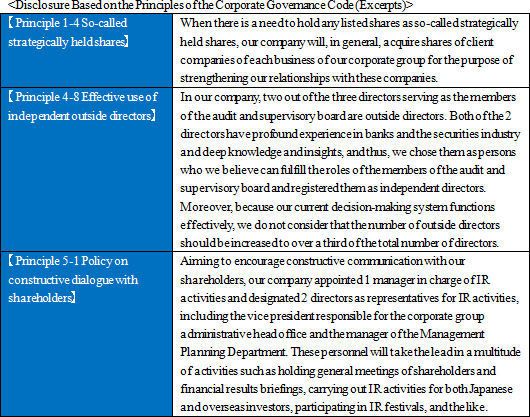 <Disclaimer>
This report is intended solely for information purposes, and is not intended as a solicitation to invest in the shares of this company. The information and opinions contained within this report are based on data made publicly available by the Company, and comes from sources that we judge to be reliable. However we cannot guarantee the accuracy or completeness of the data. This report is not a guarantee of the accuracy, completeness or validity of said information and or opinions, nor do we bear any responsibility for the same. All rights pertaining to this report belong to Investment Bridge Co., Ltd., which may change the contents thereof at any time without prior notice. All investment decisions are the responsibility of the individual and should be made only after proper consideration.Copyright(C) 2018 All Rights Reserved by Investment Bridge Co., Ltd. |

